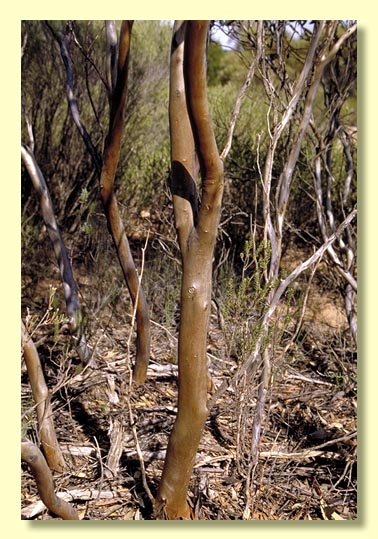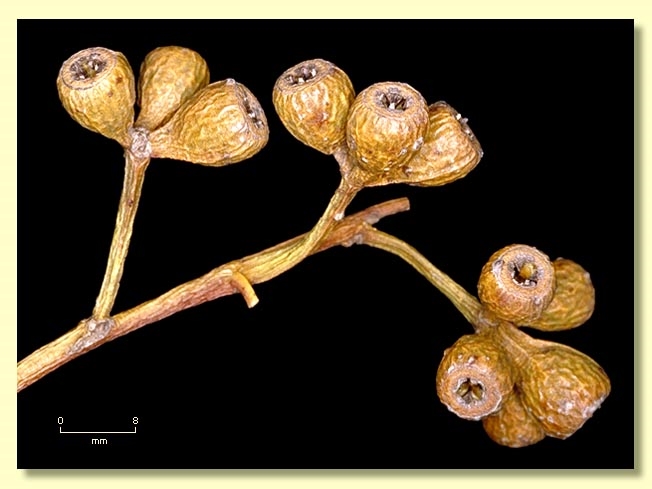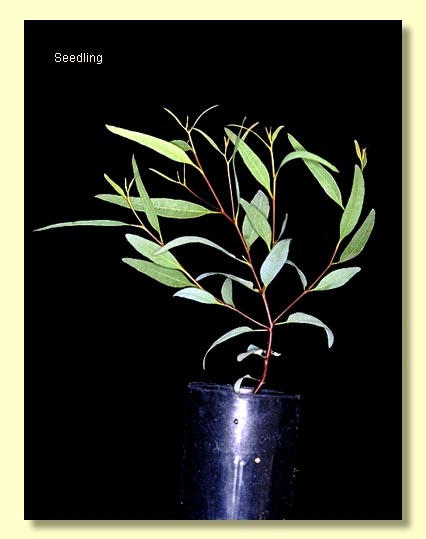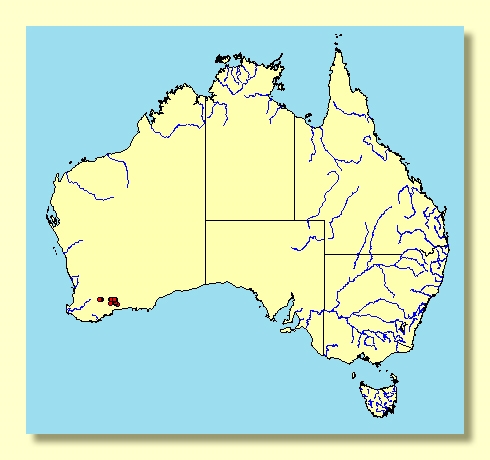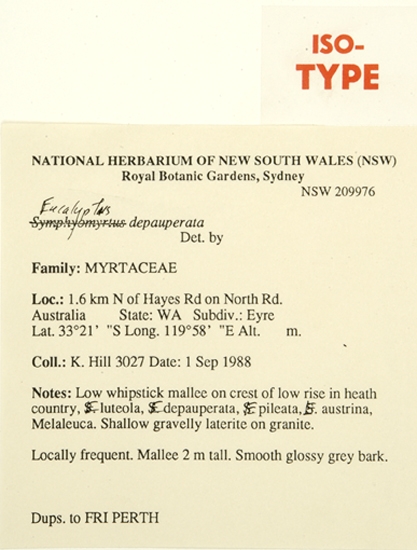Eucalyptus | Symphyomyrtus | Bisectae | Glandulosae | Erectae | Abundae
Euclid - Online edition
Eucalyptus depauperata
Bark pale grey to grey and salmon-brown.
Branchlets with oil glands in the pith.
Juvenile growth (coppice or field seedlings to 50 cm): stems rounded in cross-section; juvenile leaves always shortly petiolate, alternate, oblong-elliptical to linear, 3–6.5 cm long, 0.7–2 cm wide, green to grey-green, more or less glossy.
Adult leaves erect, alternate, petioles 0.3–1.2 cm long; blade linear to narrowly elliptical, 3–7.7 cm long, 0.4–1.5 cm wide, base tapering to petiole, margin entire or distantly indented, concolorous, glossy, green, the surface appearing "glazed", apex usually pointed, side-veins acute or obscure, reticulation invisible, intramarginal vein usually obscure, oil glands numerous.
Inflorescence axillary unbranched, pendulous, peduncles flattened, 1.5–3.5 cm long, buds 7 per umbel, pedicellate (pedicels 0.3–0.8 cm long). Mature buds asymmetrically fusiform (1.6–2.4 cm long, 0.5–0.6 cm wide), scar present (outer operculum shed early), operculum bluntly horn-shaped, ca 2–3 times the length of the hypanthium, stamens erect, anthers oblong, versatile, dorsifixed, dehiscing by longitudinal slits, style long and straight, stigma rounded, locules 4, the placentae each with 4 vertical rows of ovules. Flowers lemon-yellow, rarely pink to red.
Fruit down-turned, pedicellate (pedicels 0.3–1 cm long), cupular to obconical, 0.8–1 cm long, 0.6–0.9 cm wide, disc descending, obscured by persistent staminophore, valves 4, held at rim level.
Seeds dark brown, 0.7–2 mm long, ovoid to flattened-ovoid, dorsal surface shallowly and clearly reticulate, hilum ventral.
Cultivated seedlings (measured at node 10): cotyledons Y-shaped (bisected); stems rounded in cross-section; leaves always shortly petiolate, opposite for 3 to 5 nodes then alternate, narrowly lanceolate, 6.5–8 cm long, 0.8–2.5 cm wide, dull, grey green becoming green.
Flowering has been recorded in October and November.
A slender short whipstick mallee endemic to Western Australia, occurring in the southern wheatbelt, particularly in the Lake King area, but extending south-east towards Munglinup. The stems are smooth-barked and the adult leaves glossy, green.
Eucalyptus depauperata belongs in Eucalyptus subgenus Symphyomyrtus section Bisectae subsection Glandulosae because the buds have an operculum scar, cotyledons are bisected and branchlets have oil glands in the pith. Within this large subsection (ca 80 species) E. depauperata is closely related to a group of mallees and mallets (series Erectae subseries Abundae) recognised by the glazed leaf surface, leaves with a great density of oil glands that obscures the venation, peduncles long and flattened, inflorescences spreading and buds with a long operculum and erect stamens.
The 14 species in subseries Abundae are loosely grouped as follows. There are five species here considered to form the E. eremophila group—E. depauperata, E. eremophila, E. incerata, E. tenera and E. tephroclada. All have non-ridged buds and fruit, which separates them from the following species, E. goniocarpa, E. platypus, E. utilis, E. mimica, E. steedmanii and E. alipes. E. suggrandis, whilst generally non-ridged, has much smaller buds than the five species of the E. eremophila group, and has warty opercula. E. spathulata and E. orthostemon also have non-ridged small buds very narrowly linear leaves.
The five species in the E. eremophila group are segregated by size of buds and fruit and presence and absence of white wax on stems, leaves, buds and fruit. E. depauperata has the smallest buds 1.6–2.4 cm long. The non-glaucous mallet E. eremophila and the heavily waxy mallee E. incerata have the largest buds and fruit and occur generally to the east of the southern wheatbelt.
Two mallee species, the non-glaucous E. tenera and the slightly waxy E. tephroclada have very similar slender buds and fruit that are generally smaller than in typical E. eremophila. The only difference between E. tenera, which is widespread in the southern and central wheatbelt, and E. tephroclada, more restricted to the Hyden-Southern Cross area, is in the presence of white wax in the latter.
E. depauperata, according to Hill & Johnson (1991) when describing the species, is "distinguished within the E. eremophila group by the small leaves, buds and fruits". We have found even at its type locality south-east of Lake King that E. depauperata grows with plants that look more like E. tenera.
Whilst the five species that now make up the E. eremophila group are included in this edition of EUCLID it is not always possible to assign individual plants to one or other of the names with certainty.


